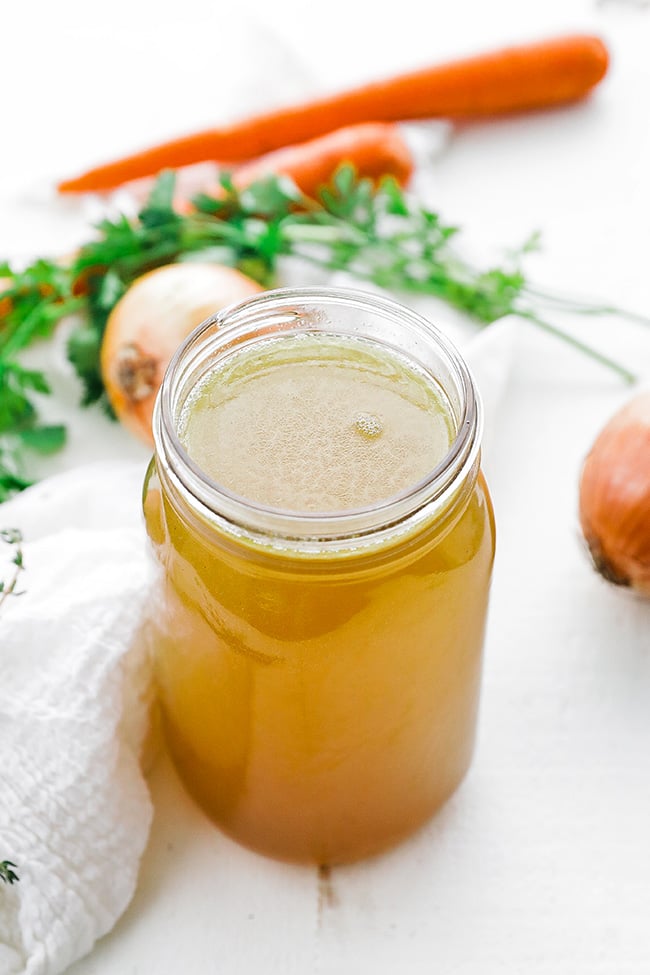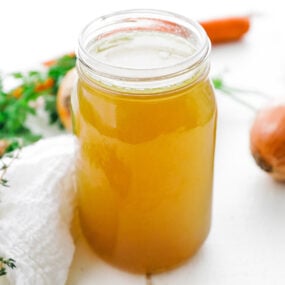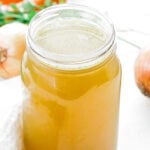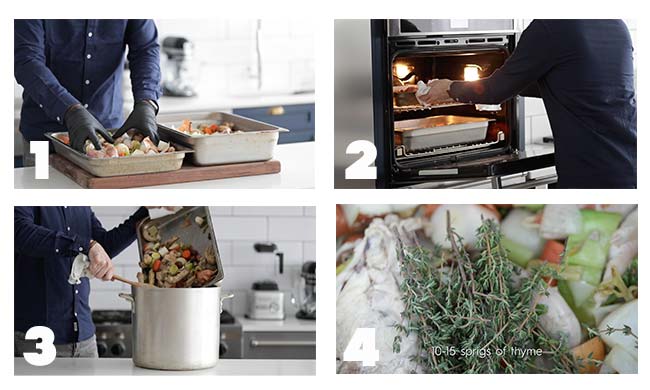Homemade Chicken Stock
Published September 3, 2024. This post may contain affiliate links. Please read my disclosure policy.
Learn how easy it is to make homemade chicken stock, enhancing the flavor of your soups and sauces. You can immediately taste the difference between this recipe and a store-bought one, and there’s no going back.
Stock is used in so many different recipes in the restaurant industry that it’s seriously one of the most coveted kitchen tools. From risotto to heating vegetables to sauces and making delicious soups, stock is a must-have in any kitchen and is straightforward.

Chicken Stock
Chicken stock is a chicken-flavored liquid made from chicken bones, meat, vegetables, herbs, and water, slow-cooked for 4-6 hours. It’s then drained and reserved for any cooking occasion. This is often the base for most soups and many sauces.
Roasting the bones and vegetables to make a “brown stock” can further enhance the flavor of a basic stock. While I do it in this recipe, it is not necessary. You can alternatively add everything to a pot, cover it with water, and cook it.
Chicken Stock Vs. Broth
Stock is a roasted chicken bone broth slowly simmered in water with herbs and vegetables. The bones from the chicken make the broth gelatinous and extremely rich in flavor.
Broth is a thin chicken-flavored liquid that has chicken meat cooked into it with vegetables and herbs. It is often seasoned with salt and pepper and is most certainly what is in those boxes at the grocery store.
Both stock and broth are delicious, but the bones give stock a much richer flavor.
Ingredients and Substitutions
- Chicken – This can be an assortment of chicken parts, including feet, skin, necks, carcasses, bones, breasts, thighs, drums, or wings. For this to be a correct stock, chicken bones, in some way, need to be included. I find it best to use carcasses.
- Vegetables – The most common vegetables are onions, celery, carrots, and garlic. However, other great vegetables include mushrooms, leeks, parsnips, vegetable peelings, shallots, zucchini, and squash. Do not use turnips, beets, or bell peppers. These things can significantly alter the flavor and, at times, cause the stock to be bitter,
- Fat – Butter, ghee, chicken fat (schmaltz), or olive or avocado oil will work. This is used to coat the bones and veggies for roasting to intensify the flavor.
- Herbs — I use thyme and flat-leaf parsley. However, the stems of these herbs are also great. In addition, I also add a few bay leaves to it,
- Spices – Whole peppercorns are used to flavor the stock as well.
How to Make Homemade Chicken Stock
- Add the chicken and vegetables to some roasting pans and rub them down with olive oil. I prefer to use a couple of different pans so that they can all be roasted.
- Roast the pans in the oven at 425° for 45-60 minutes or until they are browned.
- Transfer the roasted chicken and vegetables from the pans to a large pot and place them on the stove. When there’s a large stockpot with a spigot, it’s known as a marmite!
- Add the thyme, parsley, bay leaves, and peppercorns to the stock.

- Fill the pot up with cold water until it is 6 inches over the ingredients into the pot.
- Simmer on low heat for 4-6 hours, skimming the impurities off the top every 45 minutes.
- Strain it and store it. After 6 hours, it will not extract much more flavor.

Can I Reuse the Bones and Vegetables?
A remouillage is a stock that is made from the bones and vegetables that have already been used in a stock. After you strain the first stock, add the bones and vegetables back to the pot, refill it with water, and make a second stock.
While the flavor of a remouillage is much more subtle than the original chicken stock, it’s an affordable option for people or restaurants looking to extend the amount of chicken stock they need.
Make-Ahead and Storage
Make-Ahead: This can be made up to 3 days ahead of time for freshness.
How to Store: Once it has cooled, cover it and keep it in the refrigerator for five days. Cover it and freeze it for up to six months. Thaw it in the fridge for one day before reheating.
How to Reheat: To reheat it, add your desired amount to a saucepot and heat over low to medium heat until hot.

CHEF NOTES + TIPS
- This can easily be made using all leftover ingredients. If you often fabricate a whole chicken to use in your cooking, it’s important to freeze the carcasses. Any leftover bones should also be frozen.
- I like to freeze these in 32-ounce containers, which makes it easy to pull out what I need and allows for quicker thawing.
- It is okay to eyeball the sizes of the onions, celery, carrots, leeks, and herbs. These details won’t affect the recipe.
Recipes Using Chicken Stock

Video
Homemade Chicken Stock Recipe

Ingredients
- 5 pounds chicken bones
- 4 roughly chopped medium size onions
- 4 roughly chopped carrots
- 1 roughly chopped bunch of celery
- 2 roughly chopped leeks, green parts ok
- 2 cups button mushrooms
- 2 cups cremini mushrooms
- 6-8 garlic cloves
- ¼ cup olive oil
- 10-15 sprigs of fresh thyme
- 1 bunch Italian flat leaf parsley
- 3-4 bay leaves
- 15-20 peppercorns
Instructions
- Preheat the oven to 425°.
- Add the chicken, onions, carrots, celery, leeks, mushrooms, and garlic to a large pan or 2 roasting pans.
- Evenly drizzle the oil over the ingredients and mix until coated.
- Roast in the oven at 425° for 45-60 minutes or until lightly browned.
- Transfer the ingredients to a huge stockpot and place them on the cooktop.
- Add in the thyme, parsley, bay leaves, and peppercorns, and fill it with water until the ingredients in the pot have been covered by 6 inches.
- Simmer on low heat for 4-6 hours while skimming the impurities off of the top every 45 minutes.
- Strain entirely through a chinoise or fine mesh strainer. Cool the stock completely and store it.




Delicious! Great recipe! I always roast bones for beef stock but, never thought to do it for chicken stock. I will admit the color through me for a bit but, looks like that deep rich color is what we are going for!
Happy Cooking
🇺🇸
I absolutely love this recipe. Chef Billy, I love the way you cook and your techniques that you share. I am no where near a professional chef, but family has approved your recipes.
Love this recipe. I’ve been making stock for a while, mainly for a gravy base on thanks giving snd Christmas dinner and I never realized the difference roasting the veggies would make.
I also never thought to save veggie peels but now it’s common to see a half a dozen zip locks in my freezer.
I still save any chicken carcasses I may have and roast them too but I did merge this recipe with another and got good results. If I’m looking to make a large pot of stock I’ll follow everything on this recipe but I’ll also add a full uncooked chicken to the pot at the beginning. I found you get a more flavorful stock.
And this might be odd but rather than do the second boil for more stock I take all of the boiled down veggies, all the meat from the boiled chicken and shred up and make little patties for my dogs. They love it. And it’s healthy. I had to devise a way to separate out the onion though as that’s not healthy for dogs but that’s just a matter of roasting them separate and then boiling them in a strainer at the top of the stock pot.
If I roast a chicken tonight and save the bones and carcass in the freezer, can I just use that in the future while skipping the step of roasting?
you could
Hi Billy,
So happy to have found your website and blog! I live near St. Louis and I’m a hopeless foodie and a good cook, always looking to improve. In fact, tonight I’m going to have a zoom cooking lesson with one of our area’s top chefs. His name is Rick Lewis, owner of Grace Meat + Three and a James Beard nominee. I too make my own chicken stock and roast everything first. A couple of variations I do on your recipe is that I add a bunch of dill along with the parsley, and I use three parsnips. I’ve never used mushrooms but I’ll add them next time. You’re so right that nothing compares to the homemade version.
Love how easy this is.
This is so simple, but makes all the difference – so good!
Homemade stock is really the best! Thank you for the tips!
This a fantastic stock recipe. I love all the rich flavors in it. Thanks for the tip about remouillage. I’ve always wondered if you could make a second batch of stock.
There’s nothing better than homemade stock! Love this recipe!